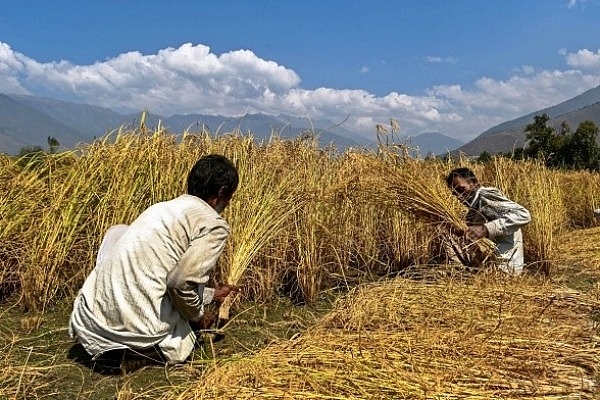Insta
For The Farm Aadmi To Succeed, What’s Needed Is Proper Method, Not Random Agriculture

Labourers seen reaping paddy in a field in Srinagar (Photo by Saqib Majeed/SOPA Images/LightRocket via Getty Images)
With the Indian agriculture sector growing at less than four per cent per annum, it would take at current pace at least 25 years for farmers’ income to double. But the Modi government’s aim to achieve it by 2022, in less than five years, looks ambitious, says a report in The Hindu Business Line.
The government, however, has introduced various new policy schemes like creation of market linkages (eNAM), ensuring availability of quality seeds, implementing soil health cards and raising minimum support price (MSP) for select crops. But the objectives can be met only on one condition: If Indians change the way they farm.
Farmers sow seeds by broadcasting them across the field. They do not follow any particular norm with respect to spatial distance or the right depth for sowing the seed. This prevents the plants from getting optimum nutrients from soil thus hurting yield. When it comes to irrigation, farmers just flood-irrigate the field. Only 8.4 million hectares of 100 million hectares of cultivable land in the country are drip-irrigated. Even here, farmers water their fields without monitoring weather conditions or after studying soil moisture.
When it comes to crop care, farmers decide to spray fertilizer, pesticide or weedicide after a cursory walk through the field. It is neither based on a close scrutiny of the crop nor directed only at those plants or areas that are affected. Also, very few farmers use the drip irrigation system to fertigate the plants. Their call on when to harvest the crop is not scientific either. It is not the maturity of the crop but historical practice and herd mentality that drive the decision.
All these have meant that farmers spend more than what they should when it comes to input cost and end up with lower than potential yield. This coupled with dependence on unpredictable monsoons has made agriculture, as father of Indian Green Revolution, MS Swaminathan, often says, the riskiest business in India as reported by The Business Line.
By taking up precision farming farmers bring in a measure of accuracy in everything they do. And it is not rocket science. Tractors fitted with sensors are available to help them till the land to the exact depth that the crop needs. They can divide their fields into various quadrants and test them for NPK and other nutrients. Today even satellite imagery can be used to identify nutrient level in the soil. Remedial actions can be taken based on need. Equipment is available to sow crops at prescribed spatial distance and at the right depth.
Due to obvious reasons, precision farming comes at a cost — ₹2 lakh per hectare. As per TBL, adapting technology for typical small Indian farms and illiterate farmers is a challenge too. But models are already available to deal with these issues. Farmers with small land holdings are already hiring tractors and other farm equipment, instead of buying them, from custom hiring centres in various states or from other private initiatives like Mahindra group’s Trringo App or TAFE’s J-Farm Services platform to name a few. This network can also be used to offer precision farming related services on a pay per use basis.
The government, for its part, should re-orient subsidies away from products to technology-based farming. It must also enhance capacity building, especially among extension workers, to teach precision farming to the farmers. Markets need to be developed to absorb the additional output that will come with special emphasis on value addition through processing of the produce. Otherwise, the benefits of precision farming will be lost due to low prices.
Finally, precision farming makes agriculture less risky and more engaging which will draw youngsters into the profession. It is also a good way to ensure India’s food security.
Support Swarajya's 50 Ground Reports Project & Sponsor A Story
Every general election Swarajya does a 50 ground reports project.
Aimed only at serious readers and those who appreciate the nuances of political undercurrents, the project provides a sense of India's electoral landscape. As you know, these reports are produced after considerable investment of travel, time and effort on the ground.
This time too we've kicked off the project in style and have covered over 30 constituencies already. If you're someone who appreciates such work and have enjoyed our coverage please consider sponsoring a ground report for just Rs 2999 to Rs 19,999 - it goes a long way in helping us produce more quality reportage.
You can also back this project by becoming a subscriber for as little as Rs 999 - so do click on this links and choose a plan that suits you and back us.
Click below to contribute.
Latest